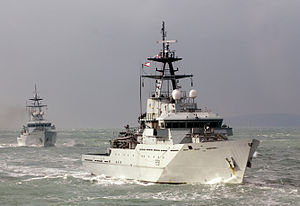HMS Tyne (P281)

HMS Tyne on exercise in 2011
|
|
| History | |
|---|---|
|
|
|
| Name: | HMS Tyne |
| Operator: | Royal Navy |
| Ordered: | April 2001 |
| Builder: | Vosper Thornycroft |
| Launched: | 27 April 2002 |
| Commissioned: | 4 July 2003 |
| Homeport: | Portsmouth |
| Identification: | Pennant number: P281 |
| Status: | in active service |
| General characteristics | |
| Class and type: | River-class patrol vessel |
| Displacement: | 1,700 tonnes |
| Length: | 79.5 m (260 ft 10 in) |
| Beam: | 13.5 m (44 ft 3 in) |
| Draught: | 3.8 m (12 ft 6 in) |
| Installed power: | 4,125 kW (5,532 hp) at 1,000 rpm |
| Propulsion: | Two Ruston 12RK 270 diesel engines |
| Speed: | 20 kn (37 km/h) |
| Range: | 5,500 nmi (10,200 km) |
| Endurance: | 21 days |
| Boats & landing craft carried: |
Two rigid inflatable boats |
| Troops: | 20 |
| Complement: | 30 |
| Armament: | |
HMS Tyne is the sixth Royal Navy ship to carry the name Tyne. She is a River-class offshore patrol vessel built by Vosper Thornycroft in Southampton to serve as a fishery protection unit within the United Kingdom's waters along with her two sister ships Mersey and Severn. All three were commissioned into service in 2003 to replace the five older Island-class patrol vessels.
Tyne was featured in the first episode of the BBC series Empire of the Seas, "How the Navy Forged the Modern World, Heart of Oak", presented by Dan Snow
The ships have large working decks to allow the vessels to cope in several roles, such as disaster relief, fire fighting, rescue work, and interception of other vessels. For this purpose a crane capable of lifting 25 tonnes is fitted, to enable standard containers to be used. The deck is also large enough to permit the transport of other craft such as oil spill recovery tractors and landing craft.
Her affiliations include North Tyneside Council, St Catherines Primary School, Hadrian Special Needs Primary School, TS Caledonia (Peterhead Sea Cadets unit), TS Tyne (Newburn Sea Cadets unit), and the Worshipful Company of Butchers.
...
Wikipedia
